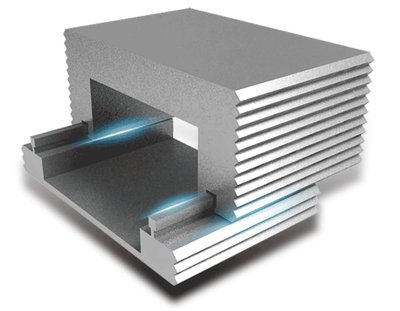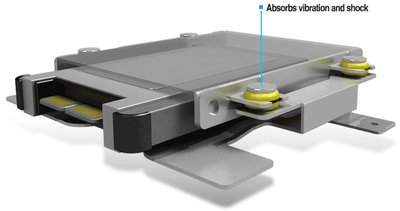How to build industrial computers that resist vibration and shock
Industrial computer manufacturers need to deliver a product that is rugged, hardened and reliable to a degree beyond the consumer standard. These requirements exist because industrial computers are often deployed in severe conditions and harsh environments, sometimes even on moving vehicles. One key industrial requirement is vibration and shock resistance, which allows industrial computers to operate in truly extreme conditions.
There are some industrial applications, such as in moving vehicles, where vibration and shock are the most significant factor affecting the stability and reliability of system operations. Computers in vehicle applications are deployed on moving objects that rattle and shake, so antivibration and antishock technology is a central requirement. In some cases, such as in rolling stock applications with network video recording (NVR) systems, high storage capacity is needed. Hard disks would be the most reasonable and cost-effective way to store all of this data, but deploying hard disks in a high-vibration high-shock environment is a significant challenge.
This article first explains some background about the physics behind vibration and shock, and then explores the specific mechanisms and technology used to build an industrial computer with high resilience against vibration and shock.
About vibration
Physically, there are two kinds of vibrations: free vibration and forced vibration. Free vibration occurs when a mechanical system is acted on by an initial input and then allowed to vibrate freely. Forced vibration occurs when an oscillating force or motion is applied to a mechanical system.
About resonance
In physics, resonance describes how a system can oscillate at large amplitudes at specific, resonant frequencies. An important point that all engineers must keep in mind is that a low amplitude force acting at the system’s resonant frequency can create extremely large displacements.
Resonance occurs in systems that can convert back and forth between stored (or potential) energy and kinetic energy. The classic example of a resonant system is a pendulum, which alternates between states of high-kinetic and low-potential energy (when the pendulum moves through the vertical position at the bottom of its swing) and low-kinetic and high-potential energy (when the pendulum slows down and then reverses direction). The pendulum will swing at its resonant frequency if the only external force is gravity. Although a simple pendulum has only one resonant frequency, more complex systems can have two or more resonant frequencies (see Figure 1).

Failure theory
Once we understand how resonance is created, we can work to reduce it by adopting special designs and technology. One way to do this is by applying failure theory to predict the vulnerabilities of an industrial system and then use these results to design industrial computers that are highly resilient against vibration and shock. Two specific concepts in physics are highly pertinent when it comes to vibration and shock - leverage and asymmetrical balance.
Leverage
The most stable point of a see-saw is the pivot point. Engineers can use a similar principle when deciding where to place vulnerable system components, such as the hard drive. Because the fulcrum of the system board remains stable, components placed there will experience less vibration and shock no matter how much the board shakes.
Asymmetrical balance
Most computers are fairly symmetrical, simply because symmetrical systems are easier for engineers to design and develop. However, symmetrical systems also tend to be more resonant in severe conditions, and particularly in moving vehicles. An asymmetrical design is an effective way to reduce system resonance and minimise vibrations and shock. A system that is asymmetrically balanced can disrupt energy wave transmissions and reduce vibrations. This concept can be applied to off-the-shelf hard disks to create a cost-effective yet reliable storage solution for high vibration applications (see Figure 2).

System-wide design perspective
An effective industrial computing system needs to approach antivibration and antishock from a comprehensive system-wide perspective. A thorough understanding of the narrow component perspective is important, but it is also important to understand how each component fits together into the big picture of a broader antivibration and antishock technology. This means that hardware, thermal design and component engineers need to collaborate to create the optimal, integrated system solution.
Mortise and tenon joints
The constant movement of high vibration environments causes constant stress on the mechanical joints in a device. Rigid screws, joints and bindings perform poorly in these environments. In contrast, a mortise and tenon joint is simple, strong and flexible. Tenon joints are a unique strategy that bestow greater vibration and shock resilience on computing systems (Figure 3).

Material selection
Aluminium alloy
When it comes to exterior casing, aluminium alloy is a superior material compared to sheet metal, because it is stronger, more rugged and can endure more vibration and shock. Aluminium alloy is light, easy to shape and also has high heat conductivity, all of which provides a reliable operating platform for the entire system.

Damping material
Damping material is used to reduce the impact of vibration and shock. As part of an overall antivibration strategy, it is particularly useful as a tool to finetune the characteristics of the antivibration and antishock design.

Component selection
Traditional computers usually use standard DIN 41612 connectors to connect the computer and its modules. However, the compact PCI connector is a better solution for industrial computers as it transmits signals more efficiently and can resist more vibration and shock impact.
EN 50155 certification
EN 50155 certification is the European standard that covers all electronic devices used in rolling stock applications and is particularly pertinent to railway applications, but could also serve as a standard for the design of any shock- and vibration-resistant computer system. Rolling stock industrial computers must comply with the following standards for vibration and shock:
- Vibration (operational): 5 to 150 Hz 10 min/axis [acceleration: 1.0 m/s2RMS (longitudinal, transverse and vertical)]
- Vibration (non operational): 5 to 150 Hz 5 h/axis [acceleration: 7.9 m/s2RMS (longitudinal, transverse and vertical)]
- Shock: Half sine wave 50 m/s2 30 ms (longitudinal, transverse and vertical)
The EN 50155 standard is a helpful benchmark for engineers who are building computers used in high vibration and shock applications.
Conclusion
To be rugged and reliable enough for many industrial and vehicle applications, industrial computers need to be designed to resist vibration and shock. The strategies outlined above demonstrate that it is possible to build a system that is highly resistant to vibration and shock while still delivering excellent performance, features and cost-effectiveness.
Edge computing for mining and metals applications
Digitalisation through edge computing can unearth new value in mining and metals processing.
COTS hardware in oil well production and monitoring
No longer is a laptop with a four-port switch a viable engineering toolset for compliance and...
The evolution of mobile field tools
The use of mobile tools to facilitate ease in accessing field device information and plant...












